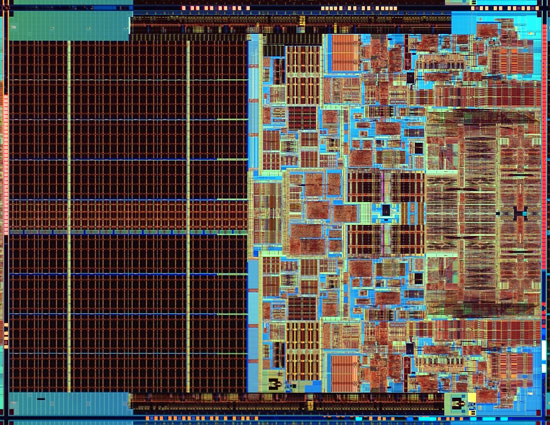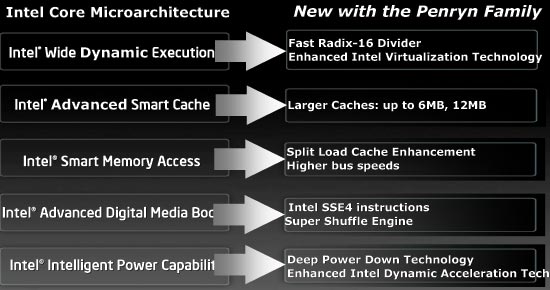The Penryn Preview - Part I: Wolfdale Performance
by Anand Lal Shimpi on August 21, 2007 12:35 PM EST- Posted in
- CPUs
By the end of this year, AMD will introduce Phenom and Intel will introduce Penryn - its first 45nm desktop CPU.
For a while there we wondered how Intel would introduce Penryn into its lineup, but as of Intel's last roadmap update we now know. On top of that, we managed to get our hands on a dual-core Penryn so now we know exactly how fast the new core is going to be. Combine the two datapoints and there's a wealth of knowledge to share. So gather 'round the fire, it's time to benchmark CPUs.
Recapping Penryn
Penryn is more than just a die-shrunk Conroe, but it isn't anywhere near as revolutionary as what Conroe was to its predecessor. The Conroe-Penryn evolution is one cycle of Intel's tick-tock model, Penryn's successor (Nehalem) will be the next revolutionary core you see out of Intel (at least that's what we're expecting).

Penryn is built on Intel's 45nm process, thus dropping power consumption increasing switching speed and allowing Intel to cram more transistors on a die (107mm^2 for dual-core Penryn vs. 143mm^2 for Conroe).

A dual-core Penryn die

A dual-core Conroe die
Intel lists the following 9 enhancements as what's new in the Penryn family:

The faster divider and super shuffle engine will increase performance in very specific applications and won't be broad increasers of performance. The larger caches obviously will increase performance, but prior to today we weren't sure by how much.
SSE4 support can bring about tremendous performance improvements, but it requires software optimization. In our initial Penryn Preview we reported an over 100% increase in performance in SSE4 optimized DivX encoding for a quad-core Penryn at 3.33GHz vs. a quad-core Kentsfield at 2.93GHz.
We detailed all of the Penryn enhancements and the markets they impact in our original Penryn article. Keep in mind that things like Penryn's Deep Power Down Technology and higher bus speeds may not apply to all Penryn cores (the former is only in Mobile Penryn while the latter will appear on servers first).
Never Take Sides Against the Family
Penryn is the overall family name but there are two cores in particular that we'll be talking about today: Wolfdale and Yorkfield.
Wolfdale is a dual-core desktop Penryn core with a 6MB L2 cache shared between the two cores. Yorkfield is two Wolfdales on the same package, giving the quad-core CPU a total of 12MB of L2 cache.
Wolfdale and Yorkfield are architecturally identical, so performance per core is no different between the processors - Yorkfield simply has more cores.










55 Comments
View All Comments
Sunrise089 - Tuesday, August 21, 2007 - link
agree w/ 1+2vailr - Tuesday, August 21, 2007 - link
How long will the socket 775 (for desktop machines) be around?Has Intel given a timeline forecast for replacing 775 with some other CPU socket? Any idea whether current P35 boards will support the 32 nm. Gesher CPU (assuming those will still be socket 775 form factor)?
zsdersw - Tuesday, August 21, 2007 - link
Socket 775 will likely disappear with the introduction of Nehalem, so no.. P35 boards will almost certainly *not* support Gesher.RamarC - Tuesday, August 21, 2007 - link
it's too bad that an upgrade now probably won't be able to handle anything beyond penryn. still a 3ghz quad core for $300 is fantastic considering that i've got 3.4ghz dual core space heater now.zsdersw - Tuesday, August 21, 2007 - link
Well, I mean, seriously.. socket 775 has been around for a long time. The same people who complain about having to buy a different motherboard are probably the same people who would complain that they aren't getting any new features if motherboards didn't have to be changed as often. It makes no sense, but then again, that's never stopped anyone from complaining.. to be sure.I'm not saying you're one of those people, though.
vailr - Tuesday, August 21, 2007 - link
Also, the TigerDirect.com price you have listed of $569.99 for the "Intel Core 2 Quad Q6600 Processor" is off.It's at $289.99 here:
http://www.tigerdirect.com/applications/searchtool...">http://www.tigerdirect.com/applications...chtools/...
kleinwl - Tuesday, August 21, 2007 - link
Why did you not post the benches for the OC of 3.22? or better yet, jack up the voltage to get a 3.33 and benchmark that? Then we could figure what the EXTREME EDITION cpu is going to do.Roy2001 - Tuesday, August 21, 2007 - link
I guess Intel does not allow him to do that.retrospooty - Wednesday, August 22, 2007 - link
Thats a good point. To release benchies at this time must have intel's OK to do so. I am sure if they let him, he would have published. And here we are all complaining LOL .gigahertz20 - Tuesday, August 21, 2007 - link
What a tease, Anand didn't even raise the CPU core voltage. I figured you would change the CPU core voltage to see how far you could overclock this beast, right after you found 3.22GHz was your max overclock at stock voltage. I want to know how far you can push this. No soup for you!